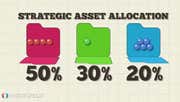Strategic Asset Allocation
 |
| Strategic Asset Allocation |
strategic asset allocation - What is a 'Strategic Asset Allocation'
A portfolio strategy that involves setting target allocations for various asset classes, and periodically rebalancing the portfolio back to the original allocations when they deviate significantly from the initial settings due to differing returns from various assets. In strategic asset allocation, the target allocations depend on a number of factors – such as the investor’s risk tolerance, time horizon and investment objectives – and may change over time as these parameters change. Strategic asset allocation is compatible with a “buy and hold” strategy, as opposed to tactical asset allocation which is more suited to an active trading approach. Strategic and tactical asset allocation are based on modern portfolio theory, which emphasizes diversification in order to reduce risk and improve portfolio returns.
BREAKING DOWN 'Strategic Asset Allocation'
For example, 60-year old Mrs. Smith, who has a conservative approach to investing and is five years away from retirement, may have a strategic asset allocation of 40% equities / 40% fixed income / 20% cash. Assume Mrs. Smith has a $500,000 portfolio, and rebalances her portfolio annually. The dollar amounts allocated to the various asset classes at the time of setting the target allocations would therefore be – Equities $200,000, Fixed Income $200,000 and Cash $100,000.
After a year’s time, suppose the equity component of the portfolio has generated total returns of 10%, while fixed income has returned 5% and cash 2%. The portfolio composition now is – Equities $220,000, Fixed Income $210,000 and Cash $102,000.
The portfolio value is now $532,000, which means the overall return on the portfolio over the past year was 6.4%. The portfolio composition now is – Equities 41.3%, Fixed Income 39.5% and Cash 19.2%.
Based on the original allocation, the portfolio value of $532,000 should be allocated as follows –
Equities $212,800, Bonds $212,800 and Cash $106,400. The table below shows the adjustments that have to be made to each asset class to get back to the original or target allocation.
Thus, $7,200 from the equity component has to be sold in order to bring the equity allocation back to 40%, with the proceeds used to buy $2,800 of bonds and the balance $4,400 allocated to cash.
Note that while changes to target allocations can be carried out at any time, they are done relatively infrequently. In this case, Mrs. Smith may change her allocation in five years – when she is on the verge of retirement – to 20% equities, 60% fixed income and 20% cash, so as to reduce portfolio risk. Depending on the portfolio value at that time, this would necessitate significant changes in the composition of the portfolio to achieve the new target allocations.
With the information we provide about strategic asset allocation
, We hope you can be helped and hopefully set a precedent with you . Or also you can
see our other references are also others which are not less good about Best Fit Moderate Allocation
, So and we thank you for visiting.
open student loan: http://www.investopedia.com/terms/s/strategicassetallocation.asp
Comments
Post a Comment